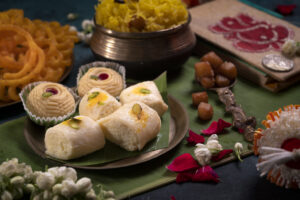Authentic Kadhi Pakora Recipe – Delightful Punjabi Cuisine
Cuisine: Punjabi
Kadhi Pakora is a delightful dish from the rich culinary landscape of Punjab. This savory, tangy yogurt-based curry, packed with crispy gram flour dumplings, is beloved across India and often serves as a comfort food during family gatherings or rainy days. The pakoras (dumplings) are deep-fried until golden, adding a crunchy texture to the smooth kadhi sauce, balancing flavors that make each bite pleasurable.
Table of Contents
ToggleThe beauty of Kadhi Pakora lies in its versatility and cultural significance. While the traditional Punjabi version is the most popular, several variations exist, including Rajasthani Kadhi, which tend to be spicier, and the Gujarati Kadhi, which is sweeter. Each version has its unique charm, but today we are focusing on the classic Punjabi style, renowned for its rich flavors and comforting essence, making it an ideal choice for family meals.
Ingredients for Kadhi Pakora
| Yogurt | 2 cups |
| Gram flour (Besan) | 1.5 cups |
| Water | 3-4 cups |
| Turmeric powder | 1 tsp |
| Red chili powder | 1 tsp |
| Salt | to taste |
| Cooking oil | for frying |
| Ginger paste | 1 tbsp |
| Garlic paste | 1 tbsp |
| Coriander powder | 1 tsp |
| Cumin seeds | 1 tsp |
| Green chilies | 2, chopped |
| Cilantro leaves | for garnish |
Preparation Steps for Kadhi Pakora
Making Kadhi Pakora is an enjoyable experience and allows you to immerse yourself in the unique flavors of Punjabi cuisine. Here’s how you can make this delectable dish:
- In a mixing bowl, combine the yogurt, gram flour, turmeric powder, red chili powder, and salt. Whisk until smooth.
- Add water gradually to achieve a smooth consistency. The batter should not be too thick or too thin.
- In a pan, heat oil for frying. Prepare the pakora batter by mixing gram flour with a bit of water, green chilies, and salt.
- Drop spoonfuls of the pakora batter into the hot oil and fry until golden brown. Remove and drain on paper towels.
- In a pot, heat a tablespoon of oil and add cumin seeds, ginger paste, and garlic paste. Sauté until fragrant.
- Pour in the yogurt mixture, stirring continuously to prevent curdling. Cook on medium heat until it thickens, about 15-20 minutes.
- Add the fried pakoras to the kadhi and simmer for an additional 10 minutes.
- Garnish with chopped cilantro before serving.
Nutritional Information
Calories per serving: 250
| Calories | 250 |
| Protein | 8g |
| Fat | 12g |
| Carbohydrates | 35g |
| Fiber | 3g |
Serving Suggestions
Kadhi Pakora is a perfect dish for family gatherings or as a comforting meal during rainy days. It can be paired with steamed rice or fluffy naan for a wholesome meal. This dish is also suitable for Kids, as the flavors are mild yet delicious, making it a hit among young eaters. Furthermore, it’s ideal for Office Tiffin since it reheats well for a satisfying lunch.
The Story Behind Kadhi Pakora
The history of Kadhi Pakora dates back to ancient Indian traditions, where yogurt was a staple in many households. It holds a special place in the cultural fabric of Punjab and is often associated with joyous celebrations and family feasts. Perhaps, one of the most joyous occasions for relishing this dish is during festivals like Diwali, when families come together to celebrate and share delicious meals.
Throughout the years, Kadhi Pakora has not only been a dish enjoyed in homes but has also seen various adaptations worldwide. The modern culinary landscape has paved the way for innovative interpretations, inviting potential business opportunities for enthusiastic food entrepreneurs. For instance, starting a brand specializing in Kadhi Pakora could tap into the growing interest in authentic Indian cuisine, appealing to a diverse audience. However, competition from established brands and eateries could present challenges.
To build a successful brand around this beloved dish, one would need to focus on the quality of ingredients, authenticity, and perhaps offer unique variations that cater to different dietary preferences. The scope for success in this niche is promising, especially as global interest in Indian culinary arts continues to rise.




